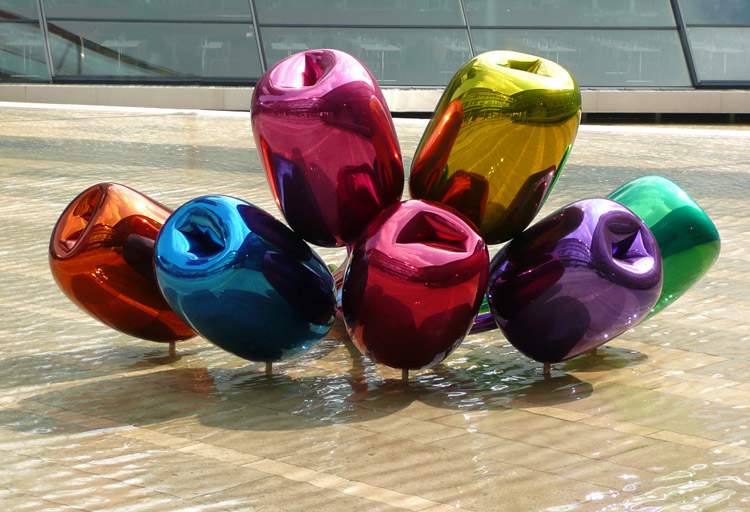Jeff Koons' waffling gift for Paris is having a lot of trouble
A popular assumption states that when giving a gift, what really counts is the thought. Last November Jeff Koons probably took the saying very literally when he announced that he would donate one of his sculptures to the city of Paris as a tribute to the victims of terrorism: a composition of colored balloons that, in shape, are supposed to resemble a bunch of tulips. An old idea, moreover, since Jeff Koons’ production abounds with similar tulip-based floral arrangements. The point is that Koons claimed that he intended to give Paris only the concept of the statue. Someone else would pay for the making of it. Le Monde, with unparalleled irony, headlined, “Jeff Koons offers us flowers but will have to pay for the vase.”
 |
| Jeff Koons’s tulips displayed in Hanover in 2004 (similar to those the artist plans to donate to Paris). Ph. Credit Axel Hindemith |
Now, however, from an article by Rachel Donadio that came out in the New York Times and was picked up by theIndependent and other outlets, it turns out that Jeff Koons’ onerous gift is dragging along quite a few problems. The private foundation that took on the burden of covering the costs of the operation (three and a half million euros) took longer than expected to gather the necessary sum. Then it emerged that the square designated to accommodate the mammoth sculpture (the bouquet, in fact, would measure about twelve meters) cannot support its weight, estimated at thirty tons. And again, the work is viewed badly by some Parisians: many consider it animposition and not the result of a shared choice. As a result, everything is now at a standstill and it is still unclear how the affair will end.
An affair that closely resembles that of the statue that the American artist announced that he wanted to donate last year to the city of Florence: in the end, however, Koons took the Pluto and Proserpina away, because the City of Florence, quite rightly, refused to place the work in Piazza della Signoria (a condition to which Koons had elegantly subordinated his gift), and proposed other accommodations to the artist. Koons, like a wayward child, would not listen to reason and demanded his gift back: the City of Florence returned it to him without flinching. The Parisian gift would seem to have the same connotation, the same assumption based on the most arrogant and waffling marketing that seeks to reverse the initial roles, with the cities to which Koons’s donations are destined turning, themselves, into a gift that the artist receives in return, moreover free of charge. Indeed: perhaps it is Koons himself who receives the most conspicuous benefits from these relationships, because the artist gets visibility, but the cities are left with his catafalques that have to be placed somewhere (unless it happens as in Florence).
As art critic Isabel Pasquier also pointed out, in a statement quoted in the article above, "Jeff Koons is a businessman, and we quickly realized that he was actually offering Paris to himself as a gift." In case there were any doubts left about Jeff Koons’s business, I think many people have been able to clear their minds following the Paris affair: under the guise ofpaying tribute to the victims of the attacks, Koons got an expected (and free) publicity to himself. Jed Perl had long ago defined Jeff Koons’s art as the “perfect vacuum”: behind the appearance made up of polished pop icons, reproduced and patinated eighteenth-century porcelain, giant gilded balloons, and all the repertoire to which Koons has accustomed us, there is absolute nothingness. A nothingness, however, that needs to feed on visibility in order to keep having that “perfect storm” of multimillion-dollar sales, fawning critics, and assertive audiences around it. And, mind you, there is nothing wrong with that. But let Koons’ circus at least stay away from the victims of the attacks. And, if it is true what Rachel Donadio claimed, namely that in Paris, minus a few opposing voices, a climate of omertà (a term used in Italian in the original text) has descended because critics fear offending Paris, Ambassador Jane Hartley who acted as a liaison between Koons and the city, or even collector François Pinault (one of Koons’s main supporters), it can be argued that Paris should, if anything, be offended by the operation itself, rather by the criticism.
Warning: the translation into English of the original Italian article was created using automatic tools. We undertake to review all articles, but we do not guarantee the total absence of inaccuracies in the translation due to the program. You can find the original by clicking on the ITA button. If you find any mistake,please contact us.





























